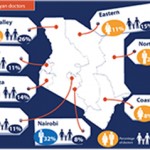Getting the Story Right – Why Engaging the Media in Public Health Strategies Makes Sense
 An assessment and media content analysis in 2012 by AVAC and USAID of seven1 East and Southern African countries cited Internews’ work with the media in Kenya as an example of best practice. The study looked at countries where Voluntary Medical Male Circumcision – VMMC in short – is being scaled up as an HIV prevention procedure.
An assessment and media content analysis in 2012 by AVAC and USAID of seven1 East and Southern African countries cited Internews’ work with the media in Kenya as an example of best practice. The study looked at countries where Voluntary Medical Male Circumcision – VMMC in short – is being scaled up as an HIV prevention procedure.
Why media, you may ask. For one, the assessment concluded that during the period when one of the countries, Kenya, was rolling VMMC out in Nyanza Province, home to the Luo which is Kenya’s largest non-circumcising ethic group, all the news stories assessed were accurate. Kenyan journalists were getting the story of this evidence-based HIV prevention strategy right.
From a media point of view, statistics and data are critical to telling the complex story of HIV prevention. That is why, when it comes to public health strategies, Internews believes that the media should not be overlooked – and especially not when you are trying to communicate a story as complex and fraught with pitfalls as VMMC. Yet many frontline organizations working in health still struggle to see how the media can be a partner in bolstering their efforts to educate people on HIV prevention and treatment efforts. Even when organizations or government health agencies want to use the media, they can lack the knowledge of how to go about this effectively.
As an impartial media training organization, Internews does not prescribe to journalists what topics to cover. But if they should choose to write about a subject such as VMMC, the challenge is that they do so accurately and fairly, rather than falling into the trap of sensationalizing a culturally sensitive medical procedure that they don’t fully understand. “Male circumcision significantly reduces the risk of [HIV] infection. That is a story. But these stories come with a challenge,” explained Ida Jooste, Internews’ country director in Kenya.
In Kenya, the media consistently polls high as a trusted source of information. Recognizing that various information channels and platforms all have the potential to contribute significantly to health-seeking behavior and community mobilization around health issues, the Internews health journalism team focused on training journalists about the science that drives VMMC as a potentially life-saving procedure. Dr. Charles Okal, Provincial AIDS and STI Coordinating Officer of Nyanza province reminded news editors during a session in Kisumu: “Most of us get our information through radio programs, newspaper articles, and television stories.”
Internews also worked closely with civil society and government health agencies engaged in scaling up VMMC, as another way to connect with the Kenyan media on complex public health topics. It meant helping them understand that reaching out to the media and their audiences did not mean that they were promoting the media. Quite the opposite – they were promoting their own work by leveraging airtime and print space as valuable resources. Following media literacy training in 2012, the country’s National Voluntary Medical Male Circumcision Task Force held a news conference that focused on women’s involvement in male circumcision.
I happened to be in Nairobi at the time of the news conference and went along to interview people for a legacy assessment of nine years’ of health journalism with a focus on HIV that I was writing for Internews at the time. Not only was it good to see how many journalists were there, but it also demonstrated the power of an approach that sees a linking up of the media with a constellation of health actors. Some 25 stories made the air or print as a result of the news conference and not one got the science wrong. Dr. Anthanasius Ochieng, VMMC Program Director of the National AIDS and STI Control Program, and the chair of the Task Force, understood the two-way process: “After the training, my view of the media changed completely. I met journalists who are passionate about their work, and they will help us communicate our position, if we communicate clearly with them.”
*A list of stories from Internews focused on VMMC, and read more about Internews’ VMMC journalism training on the VMMC Demand Creation site.
1The seven countries were Botswana, Kenya, South Africa, Tanzania, Uganda, Zambia, and Zimbabwe.








Leave a Reply
Want to join the discussion?Feel free to contribute!